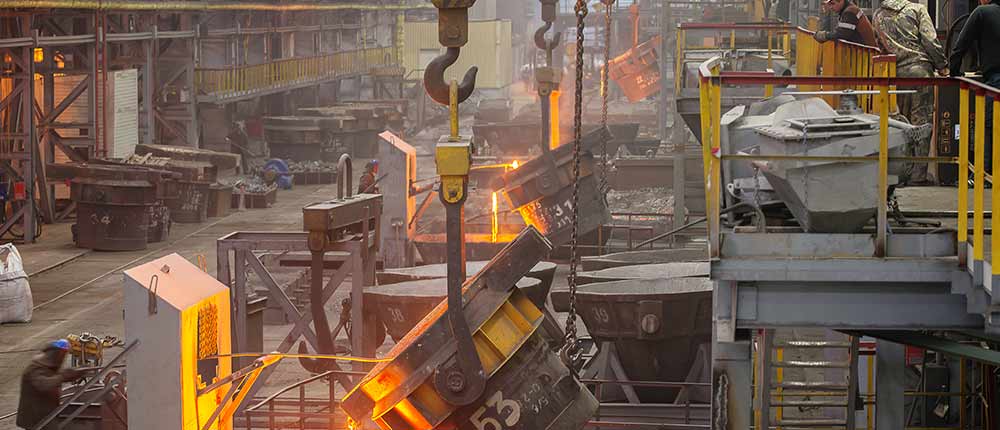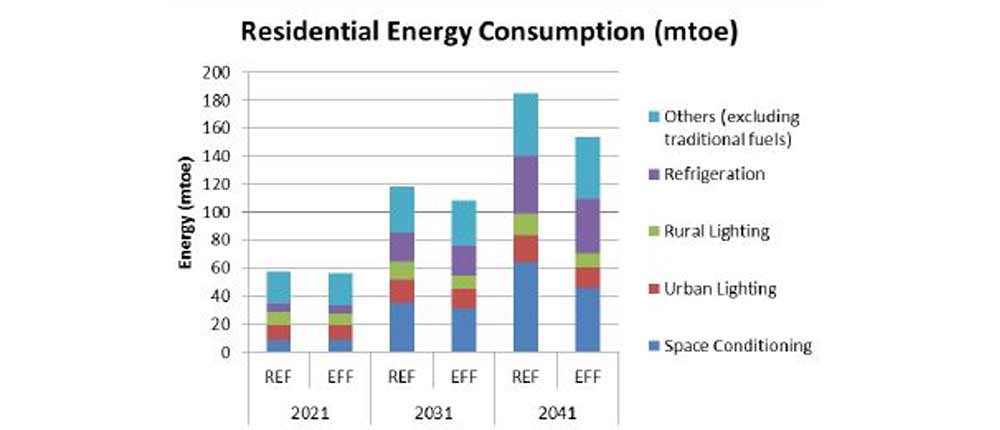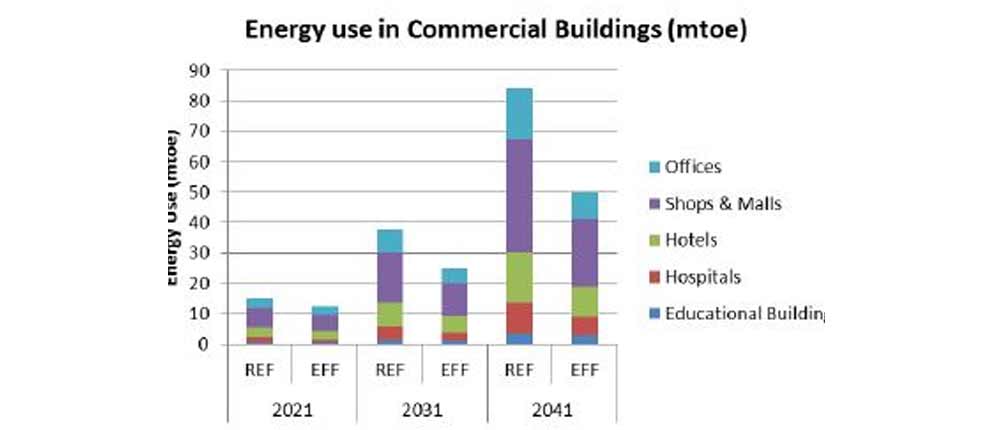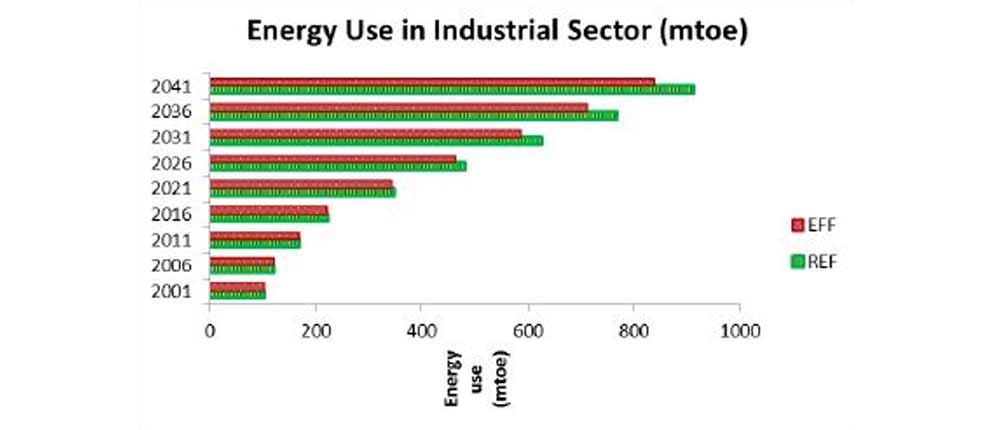A TERI analysis of energy efficiency in India by modelling two scenarios

The single largest emitter of carbon dioxide (CO2) in India is the power sector but from the demand side, largest emissions come from the industrial sector followed by the transport sector.1 From the environmental perspective also, minimising the levels of energy requirement becomes an important target as we seek to meet developmental objectives of improving (energy) access, enhancing employment, and increasing per capita incomes of our people. Every "Negawatt" that can be tapped is a boon because it can reduce the pressure on both our financial and natural resources. Energy savings can be achieved by switching to alternative technologies and/or adopting efficient devices, processes, and methods across sectors and end uses.
To evaluate this potential, TERI conducted a quick analysis of the potential for energy efficiency by modelling two scenarios that are developed to reflect an Efficiency scenario (EFF) vis-à-vis a Reference scenario (REF). The Reference scenario (REF) considers the continued adoption of energy efficient technologies and processes, based on past trends and/or at constrained levels on account of higher upfront costs and consumer choices. The Efficient scenario (EFF) considers a higher level of penetration of efficient options, faster uptake of efficient technologies and swifter phase out of inefficient alternatives fuelled by better policy frameworks and behavioural changes. The choice of technologies in this scenario was based on discussions with various sector experts, such as industry associations and manufacturers, regarding plausible enhanced penetration levels of these alternatives.
The overall results of this analysis indicate that energy efficiency can play a significant role in India’s energy transition. While the energy intensity of India's gross domestic product (GDP) has been declining at an increasing rate since 19812, implying that the low hanging fruits in energy efficiency are easily plucked, it is estimated that energy savings of up to 338Mtoe (5 - 12per cent) can easily be brought into effect over the period 2021–2041, over and above those observed in a BAU growth scenario.
Based on the analysis of two scenarios, we observe that by 2021, the emissions intensity as compared to 2006 levels, decreases by 21 per cent in the REF scenario and 26 per cent in the EFF scenario. By 2031, the REF scenario is able to achieve only the lower end of the intended nationally determined contribution (INDC) target of 33 per cent emission intensity reduction, but the EFF scenario is able to achieve around 41 per cent reduction, clearly indicating the positive role that a push to energy efficiency can provide at the overall energy sector level. The TERI analysis, also conducted at the sectoral level, is discussed in the following section.
In the residential sector, the main end-uses in which energy efficiency seems to have a significant potential are space conditioning and lighting. Although the appliances in the residential sector have already been constantly improving their efficiency in the past, and this is partly already reflected in the REF scenario as well, by 2041, energy saving potential of another 31 Mtoe (10 per cent with respect to REF scenario) can be envisaged, largely attributed to expected efficiency improvements in space conditioning and lighting technologies.

The commercial sector indicates a significant potential for energy efficiency, ranging from about 7 per cent in 2021, 15 per cent in 2031, and 18 per cent by 2041 in the EFF scenario, as compared to the REF scenario. By 2021, 2031, and 2041 as much as 3 Mtoe, 13 Mtoe, and 34 Mtoe, respectively, could be saved between the two scenarios. These savings could accrue by energy efficiency in commercial buildings as well as efficiency improvements in end-uses, such as street lighting.
However, improvements through building efficiency seem to be the largest component, mainly stemming from a very different pattern of growth emanating for buildings. So, for instance, in place of small shops, there exists the concept of malls and centrally air conditioned buildings have replaced schools and office buildings that relied on natural ventilation and basic electrical equipment. These changes can lead to large differences in the levels and patterns of energy use in these sectors. For example, an estimate indicated that the electricity consumption in the shopping malls of Mumbai accounted for a consumption of nearly 14MU per month which is equivalent to the power consumption of 12,454 rural households in India.3

In the transport sector, efficiency improvements are expected to accrue on account of shifts from road to rail-based movement and improvement in efficiencies of road-based vehicles as well as in the aviation sector. Efficiency improvements in the vehicle fleet are expected to occur in sync with autonomous efficiency improvements over time globally in the automobile industry rather than specific to India. Further, the introduction of electric vehicles is expected to lead to displacement of petroleum products, especially in the later time periods when electricity generation itself is much more decarbonized. All these elements are important for the transition within the transport sector as a whole, and can account for energy savings of 3 to 37 Mtoe (2- 6 per cent) between 2021 and 2041.
The key large energy-intensive industry sub-sectors that indicate a potential for energy efficiency improvements, include the iron and steel sector, followed by the bricks, cement, and aluminium sectors.

A first crucial step in achieving EE is to understand the sector, identify the main areas of focus, and consequently undertake rectification measures. The PAT (Perform, Achieve and Trade) scheme has been successful in reducing 9 Mtoe in the first cycle4 but the degree of understanding of how and where energy is used is perhaps more significant so that efforts can be directed at bringing in greater efficiency and reducing energy consumption in these areas.
Since many measures have already been undertaken in certain industrial sectors, the potential to achieve more may be restricted in these domains. One such example is the cement industry wherein India is among the world best in terms of efficiency levels. However, there is still a significant potential of energy savings in this sector. Iron and steel shows a potential of saving up to 45 Mtoe by 2041. Another key sector of importance is the micro, small and medium enterprises (MSME) sector which can save at least 15 Mtoe by 2041. Although a few initiatives have been undertaken by government/bilateral/multilateral organizations to help MSMEs improve their energy performance, there is a lot more that can be accomplished.
Although total energy use in the agriculture sector is not huge, use of more efficient pump sets can bring in savings of around 4 - 19 per cent during the period accounting for up to 6 Mtoe by 2041.
The potential savings discussed in the preceding paragraphs can be realized subject to overcoming the barriers and challenges that these sectors and end uses face in the uptake of energy efficiency. For instance, subsidized electricity in agriculture leads to inefficient use of pump sets and therefore such aspects need reliable energy to contain their use of energy.
Likewise in the residential sector, Delhi has started to see a peak at midnight during August-September which seems to be explained by the heavy use of air conditioners in households in the city during these months. This is a complete change from the situation in the past when the peak was seen in the evening or morning hours. Therefore, with changes in the end-uses contributing to energy growth, action also needs to be focussed differently. For example, the need for producing extremely efficient air conditioners could assume high priority to manage such peaks. Also, while there have been some success stories with the LED experience, maybe similar business models to increase the sale of cheap and efficient air conditioners could play an important role as India acquires a more urban character and develops further.
Also, while goods and equipment have been constantly upgrading the efficiency levels with the star labelling programme, among other similar measures, growth in sales and uptake among consumers has been on the higher side in comparison to what efficiency improvement has so far been able to contain.
The main barriers mentioned to the uptake of the efficient technological options are often the high upfront costs of alternative technologies and processes and/or the need for a stronger policy push/business models to scale up the uptake of the more efficient options. However, there are opportunities in some sub-sectors, such as irrigation in the agriculture sector, retrofitting in existing industrial technologies or lighting and space conditioning in the residential and commercial sectors wherein changes could possibly be brought in fairly quickly and economically.
Bringing in learning outcomes from other countries on energy efficiency measures could be relevant to maximize the gains from energy efficiency. For example, Japan has developed a carbon reduction reporting system for small and medium enterprises (SMEs) which involves both mandatory and voluntary reporting to the Tokyo Municipal Government (TMG) 5. Based on these inputs, the TMG then educates the SMEs about EE strategies to gear them in a desirable direction. In Curitiba, Brazil, an improved public transportation system has led to one of the lowest per capita gasoline consumption in Brazil despite the second highest car ownership rate.6
1. MOEF. (2010). India: Greenhouse Gas Emissions 2007. New Delhi: Ministry of Environment and Forests, Government of India.
2. Planning Commission. (2013). Twelfth Five Year Plan (2012–2017) Economic Sectors (Vol-II). New Delhi: SAGE.
3. Pachauri, R K. 2017. The Dark Side of Shopping Malls. The Pioneer, August 25.
4. Ramesh, M. 2017. Energy efficiency scheme leads to ? 37,685-crore savings for the country. The Hindu Business Line, 22 March
5. World Bank. 2010. Cities and Climate Change Mitigation: Case Study on Tokyo’s Emissions Trading System. World Bank.
6. Golub, A. 2004. Brazil's Buses: Simply Successful. ACCESS Magazine, 1(24).
Originally published in Mitigation Talks, October–December 2017
